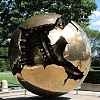The Human Dimension of North Korea
In
Log in if you are already registered
North Korea is notorious for its human rights’ violations, labor camps, bizarre provocations of the United States and a blind worship of its leaders. And these topics, of course, catch attention of Western media that usually portrays North Korea as being like something akin to the Joker from the Batman- movies, whose only plan is to make a mess of the world.
North Korean media apparently also presents to its population a very interesting vision of the West. Last week North Korean propaganda video appeared online, where America's capitalist society is portrayed as a land of homeless and hungry people suffering from gun violence.
It is interesting that we are so used to North Korea’s eccentric behavior that even most absurd information even remotely related to North Korea does not seem surprising. Thus, the English overdub to that North Korean propaganda video, describing Americans drinking coffee made of snow, eating birds from hunger and surviving off North Korean aid, was at first taken by American media in all good faith. Only later they discovered that the man who made this translation - British travel writer Alun Hill - doesn’t speak a word of Korean and simply made it as a joke.
So, it gives us some idea about how North Korean regime wants its people to perceive life in America; and it is quite amusing. But how do North Koreans live today? What do we actually now about them, apart from the fact that they are very poor, they dress alike, and adore their Dear Leader?
Global media mainly focuses on the grotesque portrait of neurotic North Korea, and pays very little attention to its people. Nevertheless, North Korea does have a human face: almost 24,5 million people live in the country, whose lives do not revolve around nuclear plans. They are regular people with their own daily concerns.
The human dimension of North Korea was very well covered in John Everard‘s book “Only beautiful, please”. He was a British Ambassador to North Korea and had a unique opportunity to observe the life outside Pyongyang and even engage in some conversations with local people. (The regime shows visitors only beautiful things, whereas everything ugly is hidden from view)
The book inspired me to look up online pictures of daily life in North Korea. I would like to share my collection of pictures about daily life in North Korea, obtained from online sources (Flickr, NBC news, the Huffington Post, AP and so on ) and from John Everard’s book.

From early childhood North Koreans learn to revere their leaders. (Photo/Thomas van Houtryve)

Portraits of the Dear Leaders accompany North Koreans through all stages of their life. Learning Center. (Photo/Thomas van Houtryve)

The Dear Leaders are watching you even when you decide to listent to some music at the Grand People's Study House in Pyongyang. (Photo/ David Guttenfelder)

A neat line for a bus in Pyongyang. You can see how patient and organized North Koreans are: nobody is marshalling that line. (Photo/John Everard)

Again, walking stride in stride when nobody is telling them to. (Photo/ David Guttenfelder)

Streets and roads in Pyongyang are very clean and well-maintained. This is a mobile hourse acquired by some enterprising North Koreans for picture taking. (Photo/John Everard)

Central Pyongyang is strikingly different from the rest of North Korea. (Photo/ David Guttenfelder)

Life in Haeju, a city in in South Hwanghae Province. (Flickr)

A remote village street that is also spotlessly clean and maintained with great care. (Photo/BBC)

Many people are riding a bicycle in North Korea, especially in the countryside. This is the center of Nampo, a city in South Pyongan Province. (Flickr)

How do women dress in North Korea? Pyongyang, Sunday. (Photo/Eric Lafforgue)

Pyongyang, weekday. North Korean people are apparently shy and don't like being photographed.

John Everard notes that North Koreans almost always spend their spare time collectively. Doing something by yourself just seems odd to them. Here is a collective game of chess. (Photo/John Everard)

Danicing rehearsal in Pyongyang.

According to John Everard, this is a picture of two assistants in an orphanage who work in impossible conditions. They look after dozens of children with limited equipment and almost nothing to give them. Such dedication is beyond inspiring. (Photo/John Everard)

This is regime's propaganda. "American imperialists look like wolves with big tongues" (Photo/John Everard)
North Korean elite is very erratic, and probably its main and only concern is to stay in power. Nevertheless, whenever we laugh at absurd actions or rhetoric of the regime, impose sanctions or provide humanitarian aid we should remember that North Korea first and foremost are its people. There is a serious dilemma about humanitarian aid to North Korea. On the one hand, the aid helps North Koreans survive from hunger today. On the other hand, it indirectly keeps the regime going. So, what is the greater good for North Koreans? Preserving the status quo? Or changing the regime and pursuing something like democracy? The problem is that North Koreans do not know any better life than under their communist regime; and obviously do not even have a chance to compare their life with the life of people in other countries.




